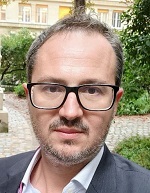ESTRO 2023 Biology Track Report
Chair: Paul Span, The Netherlands
Co-chair: Daan Boreel, The Netherlands
Speakers:
Marcel van Vugt, The Netherlands
Heidi Lyng, Norway
Erik Wennerberg, UK
Kevin Harrington, UK
In a fully packed room, Paul Span and Daan Boreel chaired a session at ESTRO 2023 that was dedicated to the investigation of tumour features that contribute to the maintenance of an immunosuppressive environment. Leveraging immunosuppression, with the final goal being to “warm up” cold tumours, is of pivotal importance in the golden era of radiotherapy-immunotherapy combinations.
Marcel van Vugt, University of Groningen, opened the session with a presentation on the immunosuppressive signals that are mediated by oncogenes. In particular, the role of the MYC MYC proto-oncogene in the modulation of inflammatory signalling of triple-negative breast cancers was considered. It can be shown that MYC overexpression in cancer cells that contain defective breast-cancer genes 1/2 (BRCA1/2) suppresses the actions of multiple inflammatory genes including those downstream of the interferon pathway. Interestingly, this can lead to resistance to agonists to the stimulator of interferon genes protein (STING), as observed in mouse models that overexpress MYC.
Then Heidi Lyng of the Norwegian Radium Hospital, Oslo, presented an interesting study in which two sets of biopsieswere analysed: cervical tumour samples that had been collected before the start of treatment and in the course of brachytherapy (after 10Gy, one week of radiation). These were analysed through the use of RNA sequencing and immunohistochemistry. The data presented showed a reduction in the levels of CD8 T-cells after irradiation, while the amounts of alpha smooth muscle actin (αSMA)-positive fibroblasts and macrophages that presented “M2” expression profiles were increased.
Next, the session organisers moved to the analysis of mechanisms of immune suppression that may contribute to the lack of response to immune checkpoint inhibitors (ICIs) that are observed in several patients. Erik Wennerberg of the Institute of Cancer Research, London, UK, presented interesting data concerning the role of ADP-ribosyltransferase 1 (ART1), the membrane expression of which is associated with poor CD8 T-cell infiltration in clinical tumour samples. He showed that, in vitro and in murine models, ART1 mediates immune resistance by inducing the death of CD8 T-cells, and by reducing the tumour infiltration by conventional type-I dendritic cells in irradiated tumours. Interestingly, an antibody directed against ART1 could reverse both these processes and improve the response to radiotherapy and cytotoxic T-lymphocyte-associated protein 4 (CTLA4) blockade. These data indicate that ART1 represents a target that could improve the efficacy of radiotherapy and ICIs combinations.
The section was closed by another eminent scientist from the Institute of Cancer Research, London, Kevin Harrington. He discussed strategies to improve radiotherapy-induced immune stimulation through the use of DNA damage response inhibitors. First, he discussed the deceiving results from clinical trials with radiotherapy and ICIs in head and neck cancer patients. The negative results strongly suggest that strategies that are alternative/complementary to those that involve ICIs should be used in such settings. One strategy relies on the use of an inhibitor of the serine/threonine ataxia-telangiectasia and Rad3-related (ATR) protein kinase. In different head and neck murine tumour models, ATR inhibitors (ATRi) have been found to modulate both immune cell infiltration and ATRi-sensitised head and neck squamous cell carcinoma tumours to radiotherapy. Moreover, ATRi and radiotherapy acted synergistically with ICIs as the monoclonal antibody directed against programmed cell-death-1 ligand 1 (anti-PD-1) and against T cell immunoreceptor with Ig and ITIM domains (anti-TIGIT), in a process that was mediated by the activity of natural killer (NK) cells. Accordingly, he presented data collected recently, which indicated that NK cells could be targets to increase the efficacy of radio- and immunotherapy combinations.

Michele Mondini
Research scientist
INSERM « Molecular Radiotherapy and Therapeutic Innovation » Unit
Gustave Roussy
Villejuif, France